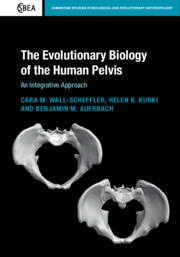Book contents
- The Evolutionary Biology of the Human Pelvis
- Cambridge Studies in Biological and Evolutionary Anthropology
- The Evolutionary Biology of the Human Pelvis
- Copyright page
- Dedication
- Contents
- Preface
- Introduction
- 1 Pelvis Anatomy
- 2 Functional Morphology of the Pelvis
- 3 Pelves of the Hominin Lineage
- 4 Developmental Biology of the Pelvis
- 5 Morphological Integration, Evolutionary Processes and Variation in the Human Pelvis
- Conclusions
- Appendix
- Works Cited
- Index
5 - Morphological Integration, Evolutionary Processes and Variation in the Human Pelvis
Published online by Cambridge University Press: 30 December 2019
- The Evolutionary Biology of the Human Pelvis
- Cambridge Studies in Biological and Evolutionary Anthropology
- The Evolutionary Biology of the Human Pelvis
- Copyright page
- Dedication
- Contents
- Preface
- Introduction
- 1 Pelvis Anatomy
- 2 Functional Morphology of the Pelvis
- 3 Pelves of the Hominin Lineage
- 4 Developmental Biology of the Pelvis
- 5 Morphological Integration, Evolutionary Processes and Variation in the Human Pelvis
- Conclusions
- Appendix
- Works Cited
- Index
Summary
In this chapter, we discuss evidence about the evolutionary forces that have shaped the evolution of the human pelvis, both in its entirety as well as portions of the pelvis, focusing on studies that have investigated pelvic evolution using experimental and quantitative genetic methods. These methods are tied to information from Chapter 4 about pelvis development, with emphasis placed on the importance of understanding the difficulty of tying development and growth with evolutionary processes. Special attention is placed on the concept of the palimpsest. Further, we review these findings in light of three principal hypotheses broadly offered about the processes that selected for pelvic shape (as reviewed in Chapters 2 and 3): locomotion, obstetric sufficiency and thermoregulation. We show from multiple studies that the human pelvis evolved in response to natural selection as well as through neutral evolutionary processes (e.g. genetic drift). A key conclusion from these studies is that parts of the pelvis evolved in different manners in response to these (and other) selection factors; thus, the shape of the human pelvis reflects a modular response to various sources of selection.
Keywords
- Type
- Chapter
- Information
- The Evolutionary Biology of the Human PelvisAn Integrative Approach, pp. 111 - 134Publisher: Cambridge University PressPrint publication year: 2020



